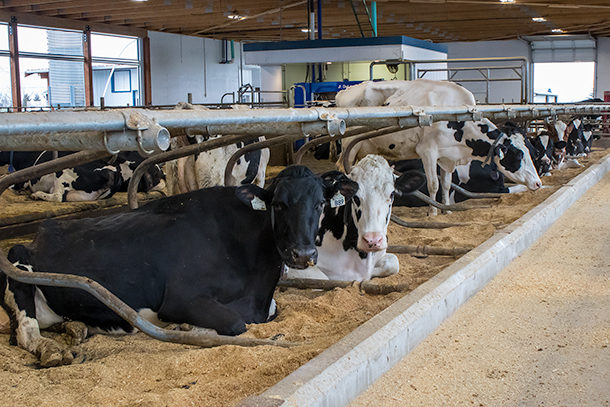This is the first of three articles in the “Flipping Your Freestalls” series. Read Part II and Part III.
In recent years, the concept of buying old houses, renovating and reselling them has been popularized by many television shows. This process is called house “flipping.” You can apply the same concept to freestall barns.
Often, an old freestall barn can be improved dramatically with a few modifications. Cow comfort generally refers to minimizing animal stress in an effort to maximize milk production and animal well-being. A properly managed and designed freestall barn can support high levels of milk production and animal well-being. On the other hand, mismanaged or poorly designed freestalls can contribute to mastitis, lameness, hock abrasions and injuries. Through years of experience observing and studying cow behavior in freestall barns, farmers, researchers and engineers have refined recommendations for freestall design and management. Additionally, as cow size has increased, so has the amount of resting space required within a freestall, effectively changing the recommendations for freestall dimensions. Dramatic improvements in cow comfort can be achieved by making some minor, relatively simple changes to existing freestalls.
Watching cows
The purpose of a freestall is to provide a cow with a comfortable, clean, dry resting area. A good freestall allows the cow to enter and exit the stall with a natural reclining, resting and rising motion, without striking the stall structure. These freestalls present minimal opportunity for injury, pain or frustration. Some freestall design considerations involve trade-offs between optimal stall usage and cow cleanliness. Often, dairy producers wonder why their cows do not spend as much time lying in their freestalls as they should. This situation is particularly problematic when cows choose to lie in manure-covered alleys rather than in the stalls.
The most effective way to determine if your freestall barn is meeting your cows’ needs is to simply watch the cows
In comfortable, well-designed freestalls, cows will spend most of their time lying or standing straight (parallel to the length of the stall) in the stall. By understanding what behaviors to look for, you can learn what minor adjustments need to be made to the standard recommendations to best fit the needs of your cows in your facilities. Watch the cows as they lie in the stalls. Think about how a cow gets up when she is on pasture. Their behavior in freestalls should be similar. Typically, a cow will first shift to move her front knees beneath her body. Then, she lunges her head forward, transferring weight to the front of her body, which also allows her rear end to be easily lifted. Next, she shifts weight to one knee and straightens the other front leg with the foot in front of the shoulder. Finally, she shifts her weight to the straightened leg, pushing up and straightening the other front leg to finalize her standing position.
Observe cow behavior in these nine areas:
- Do the cows enter the stalls with ease and with minimal hesitation?
- Do they come into contact with any part of the stall while lying down?
- Do they come into contact with any part of the stall while getting up?
- Is there adequate lunge space for their heads as they rise?
- Do you see any potential for injury as the cows get into and out of stalls?
- Do cows spend considerable time standing in the stall, showing hesitation, before lying down in the stall?
- Do they push their nose or mouth against pipes or stall structures?
- Do cows stand in the freestall, swinging their heads to the left and right? (This behavior has been termed "the hesitation waltz”).
- Once cows are lying, do they appear calm or restless? (Restlessness, or frequent changing of positions while lying, may be another sign of potential cow comfort shortcomings).
Finally, take time to look at the cows, focusing on hocks, knees and rumps. Do you see any evidence of injury, abrasions, abscesses, bumps or bruises that may have resulted from getting into and out of the stalls? If you stand in front of the stall and drop to your knees, is it a painful process? If so, how do you think this “knee test” reflects the cow’s experience in using the stall? All these observations may indicate potential improvements can be made through modifications.
Measurements are essential
Once you have observed the cows, use a tape measurer to assess the dimensions of your existing stalls. Be sure to collect measurements for all types of stalls in your barns. For example, the dimensions may be different for stalls on the outside walls or if a different type of loop is used in one row versus the others. Once you have collected this information, compare your dimensions to the recommendations listed below. Select freestall dimensions for the largest cows in your herd. Varying cow sizes within a herd should lead to varying stall sizes. A one-size-fits-all approach to freestall design is not conducive to optimal cow comfort. When possible, first lactation cows should be provided a separate pen with smaller freestalls to accommodate their smaller frame size.


It is important to recognize that optimal stall use and lying behavior are the result of a combination of factors. Changing one factor may not necessarily remedy the situation immediately. Some trial and error may be needed during the renovation process. One should not expect to see immediate results and improvements. It may take time for cows to adjust to the redesigned freestalls, and old problems (lameness, hock injuries, etc.) will not disappear overnight.











